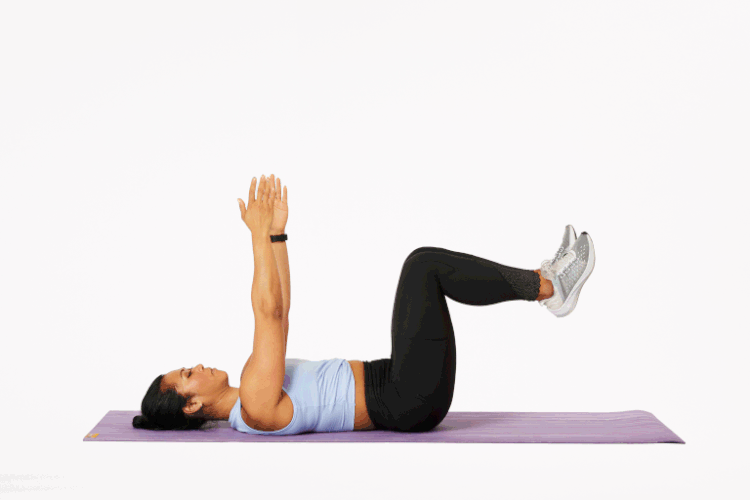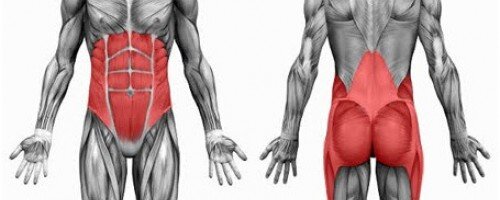
The Core Exercise That Everyone Should Be Doing
There aren’t many guarantees in life, but I can pretty much guarantee this core exercise can and will help you.
I’m talking about the dead bug. Yes, it’s an odd name. And yes, it is one of the best damn exercises you can do to improve your overall strength, health, and performance.
Before we get into that, let’s quickly review what your core is.
Your core is comprised of different muscle groups with varying functions. In other words, pumping out a shit ton of sit ups will give you a good ‘ab burn’, but probably isn’t optimal for strengthening your lower back.
There’s an ongoing debate on what the core actually is. Some say it’s comprised of the muscles wrapping around the trunk area; some say it even branches out further to the connecting limbs of the trunk region as well.
In this case, we will refer to the core as the muscles surrounding the lower back, wrapping around to the front of the abdominal wall. These muscles include:

- Erector spinae (spinal extension)
- Transverse abdominis (lower back/pelvic stabilization before arm/leg movement)
- Rectus abdominis (spinal flexion)
- Internal/external obliques (lateral flexion and rotation)
- Multifidus (lower back stabilization)
The core’s main function is to protect the spine. It’s your centre of gravity. Your base. Your foundation.
Everything stems from your core. Your balance. Your strength. Your power. Your coordination.
Without a strong core, you are limiting yourself in terms of your potential strength and performance.
Yes, your core is being worked when you perform heavy compound lifts. However, it is usually a good idea to incorporate some core-specific exercises into your workouts as well.
I know…ain’t nobody got time for that. I get it. But listen, if you squeeze in time for at least one core exercise (dead bugs), I promise you will be happy with the results.
What is the dead bug?
The dead bug is an anti-extension exercise, meaning your core is working to stabilize the spine and resist hyperextending the lower back as you extend your limbs outward. Watch the video below to see what I mean.
Why the dead bug?
There are many benefits that come with this fundamental movement.
- Minimal equipment: Do you have a body? Yes? Great. You can do dead bugs.
- Minimal space: Unless you’re Andre The Giant, you don’t need a lot of space.
- Easy to scale: It doesn’t matter if you’re a beginner. The dead bug can be scaled so people of all fitness levels can do it.
- Easy to progress: On the same note, there are tons of ways to progress the dead bug and make it harder so more advanced athletes are continuously challenged.
- Useful warm up tool: The big movements you’re doing in the gym (squat, bench, deadlift, etc) require help from the core. Perform dead bugs as part of your warm up for better performance during your workout.
- Reduces lower back pain: Remember, the core’s main function is to protect the spine. The dead bug strengthens the muscles surrounding the trunk that are specifically used to stabilize the spine while the outer limbs (arms and legs) are in motion.
How to perform the dead bug
Here’s a step by step walk through on how to do dead bugs:
- Lay on your back
- Arms straight up to the ceiling (palms facing each other)
- Legs and ankles bent at 90 degrees
- Lower back flat on the ground
- Ribs drawn down
- Inhale through the nose
- Exhale through the mouth while extending right leg and left arm simultaneously
- Inhale while coming back in
- Repeat on other side
The most important thing is to keep the lower back pressed firmly against the floor the entire time.
Why?
This is an anti-extension exercise, so the sole purpose of doing this is to train your core to be able to stabilize your lower back in a strong neutral position while your limbs are in motion. It defeats the entire purpose of the exercise when you allow your lower back to extend, causing separation between your body and the ground.
How do you keep your lower back flat?
Before you even start moving, you want to engage your core.
How?
Do these three steps.
- Neutral: Get your lower back to a “neutral” position by tilting at the pelvis. Wtf does that mean? Think something in between J-Lo (anterior pelvic tilt) and a sad dog tucking it’s tail between it’s legs (posterior pelvic tilt).
- Breathe: Breathe in through the belly (not letting the ribs flare out).
- Brace: Hold your breathe and tuck your belly button back towards your spine.
Boom. Your core is engaged.
In terms of which limbs should be moving and where to start, it depends on your current capabilities. There are variations of the dead bug that get progressively more difficult.
3 BEGINNER VARIATIONS
Master these three dead bugs before progressing to the advanced variations.
Legs Only
The best place to start is to focus on just moving one leg at a time. Keep both legs at 90 degrees the entire time, and just focus on dropping the heel to the floor one leg at a time.
It gets progressively harder the further you extend your leg. Only start to straighten your leg once you can perform the bent leg variation while keeping your lower back pressed against the floor and maintain tension in the core.
Contralateral
This means opposite sides are moving. As you straighten one leg out, extend the other arm out at the same time.
Ipsilateral
This means the same side (right leg and right arm moving at the same time). This small change makes it noticeably more challenging for your core to stabilize the spine as it has to recruit the obliques to resist the urge to rotate.
3 ADVANCED VARIATIONS
Now that you’ve mastered the fundamentals, challenge yourself with these advanced dead bugs.
Banded Dead Bug
Have two resistance bands mounted to something sturdy like a squat rig or sled (just below hip height) and hold the bands while keeping your arms straight up. The added resistance puts more tension in the core.
Dumbbell Dead Bug
Add resistance by holding a couple of dumbbells. Boom.
Dead Bug Pallof Press
Have a resistance band mounted to a squat rig at about knee height. Grab the band from the side and perform a Pallof press while doing the dead bug. This turns the dead bug into an anti-rotation and anti-extension exercise. Watch the video below for reference.
Key Points
- Do dead bugs…
- Now!




